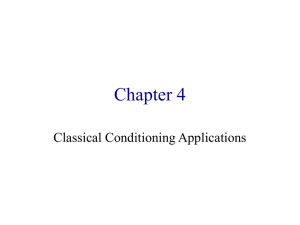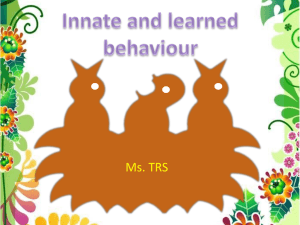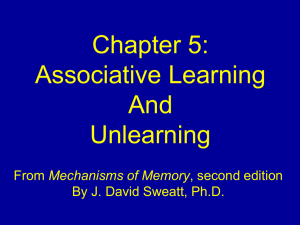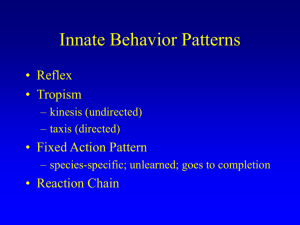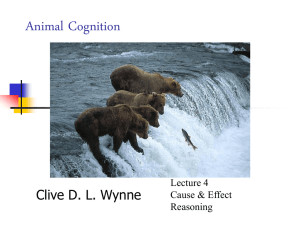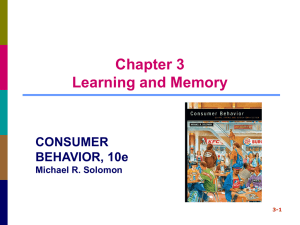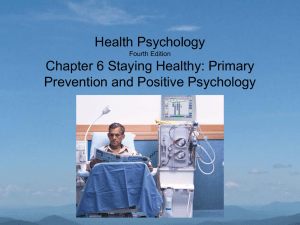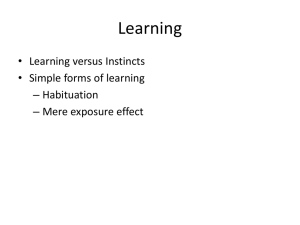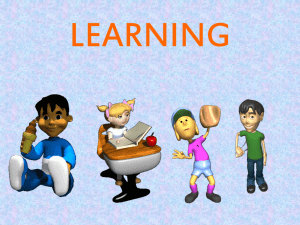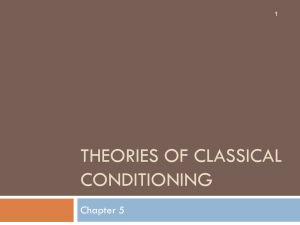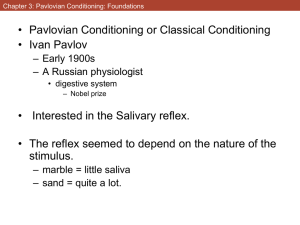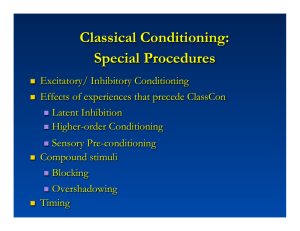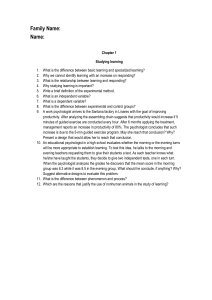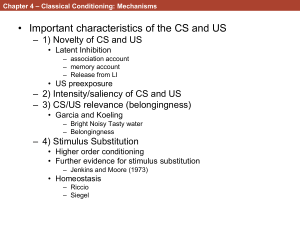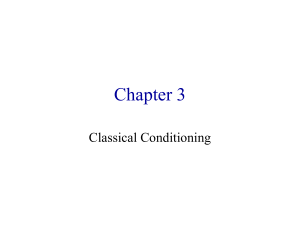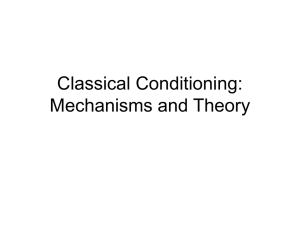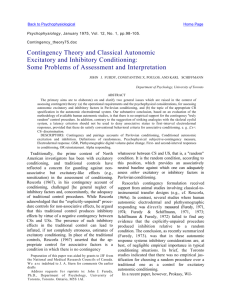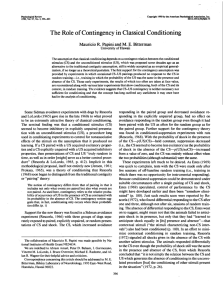PPT - UCI Cognitive Science Experiments
advertisement
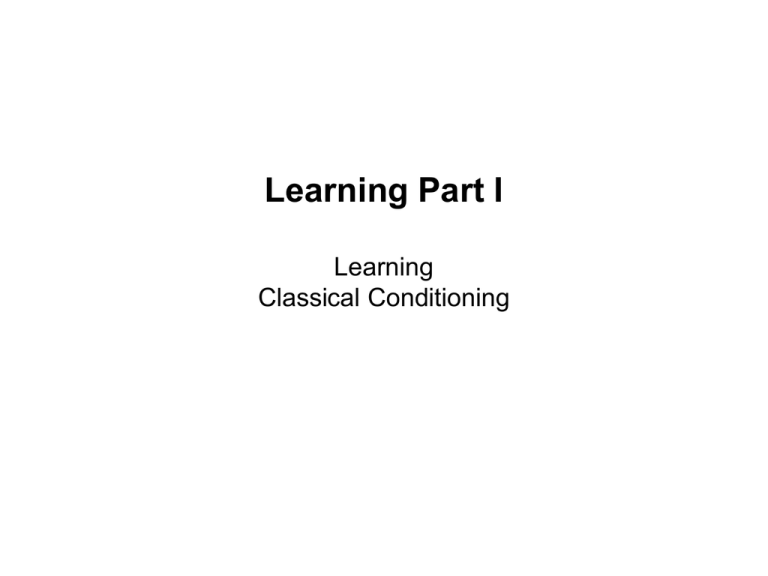
Learning Part I Learning Classical Conditioning Study of learning • Learning: – process by which long-lasting changes occur in knowledge/behavior as a result of experience Two approaches to study learning • Behaviorism (early 20th century) – studied simple learning mechanisms – introduction of stimulus-response theories – focus on animal studies • Cognitivism (1950s-present) – introduction of complex mental processes (“inside the mind”) – focus on human learning Nonassociative forms of Learning • Habituation: – An organism’s response to a stimulus will decline following repeated presentations of a stimulus. • Dishabituation – Presentation of a novel stimulus leads to an increase in responsiveness Using habituation to study infant cognition 2-month old infant Looking time 4-month old infant Looking time habituation Repeated observations of Object 1 Present Object 2 Repeated observations of Object 1 dishabituation Present Object 2 Video: habituation (40 secs) (for original video, see: http://www.youtube.com/watch?v=UiB2ZX1phmc&feature=related) Classical Conditioning • In classical conditioning, animals learn about the association between one stimulus and another. One of Pavlov’s dogs Ivan Pavlov 1849-1936 Nobel Laureate Video (~3 min.) Acquisition of a conditioned response Salivation is a physiological reflex to food. Unconditioned response A tone is presented at the same time as the food. An association between the tone and food is established. After training, the tone presented alone will elicit salivation. The UR and CR are similar, but not necessarily identical. Acquisition and extinction of a conditioned response Important Question At some point, even spontaneous recovery will be completely extinguished. Has the association been erased? No. If the dog is reconditioned following complete extinction, fewer pairings of food (US) and tone (CS) will be required to reestablish the salivation response to tone alone. Video: Little Albert (~3 min.) Conditioned Emotional Responses http://www.youtube.com/watch?v=0FKZAYt77ZM John B. Watson 1878-1958 Examples of US-UR pairings Stimulus (US) / Response (UR): • • • • Food / Salivation Electric shock / Pain reaction Food / Nausea Puff of air / Eye blink Video: conditioned eyeblink response (~2 min.) Original video: http://www.youtube.com/watch?v=Xg3WuvCrIZg Major Phenomena of Classical Conditioning • • • • • • Second-order conditioning Generalization Discrimination Temporal ordering Contingency Blocking Second-order conditioning (1) US (food) paired with CS1 (metronome) (2) CS2 (light) is followed by CS1 (metronome) followed by no food (3) CS2 (light) alone elicits CR (salivation), although at a reduced level Learning is based on establishing associations Complex behaviors are assembled from simple ones Generalization Generalization Gradient Training Pair a 1200 Hz tone with the US Testing Measure the CR when tones with different frequencies are presented Green – CS Red - US Temporal Ordering Contingency • The primary causal factor for establishing an association between the US and CS is contingency • The CS should be informative about the arrival of the US Contingency: an example Out of 200 trials: CS no CS US 60 60 no US 40 40 Lack of Contingency: The CS is not informative and no conditioning occurs Out of 200 trials: CS no CS US 60 40 no US 40 60 Positive Contingency: the US is more likely when the CS occurs and less likely when the CS does not occur. Conditioning occurs. Contingency: another example Out of 200 trials: CS no CS US 50 0 no US 50 0 e.g., CS = light that is always on Lack of Contingency: The CS is not informative and no conditioning occurs CS should provide new information about US: the blocking effect BLOCKING: Training Phase 1 Training Phase 2 Pair CS1 with US Pair CS1 and CS2 with US (establish association) tone with shock tone and light with shock Test Phase Test CS2 alone test light alone; no response (CR) There is no new or independent information provided by CS2. No conditioning occurs to CS2 .because it provides no new information about the arrival of the US. What is the conditioned response (CR)? • The CR may be a version of the UR – e.g. salivating to food might be the same as salivating to a bell • The CR may also be quite different from the UR – it might be a preparatory response to the US – organism might prepare a response that is adaptive for the US – Example preparatory response: • rats anticipating shocks • anticipatory responses to caffeine • “pre-game jitters” Compensatory conditioning • Sometimes the preparation takes the form of a compensatory response • Examples: • drug addiction • rats in ice boxes Classical Conditioning and Overdose Deaths experiment with rats (Siegel et al. 1982) This might explain why some heroin addicts die after injecting their usual amount of heroin in an unfamiliar environment For exam, bring Form F-288-PAR-L and pencil Required information
